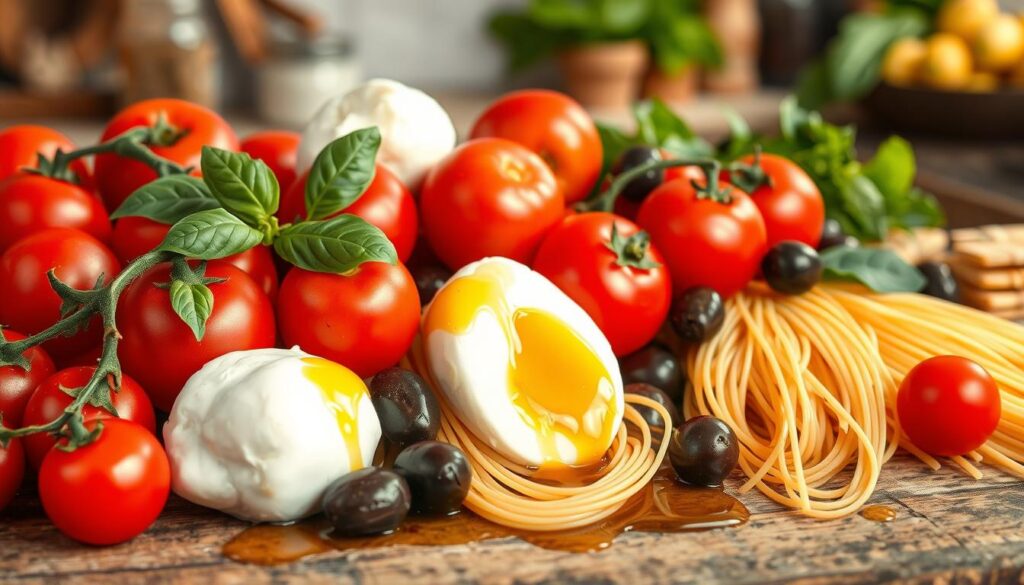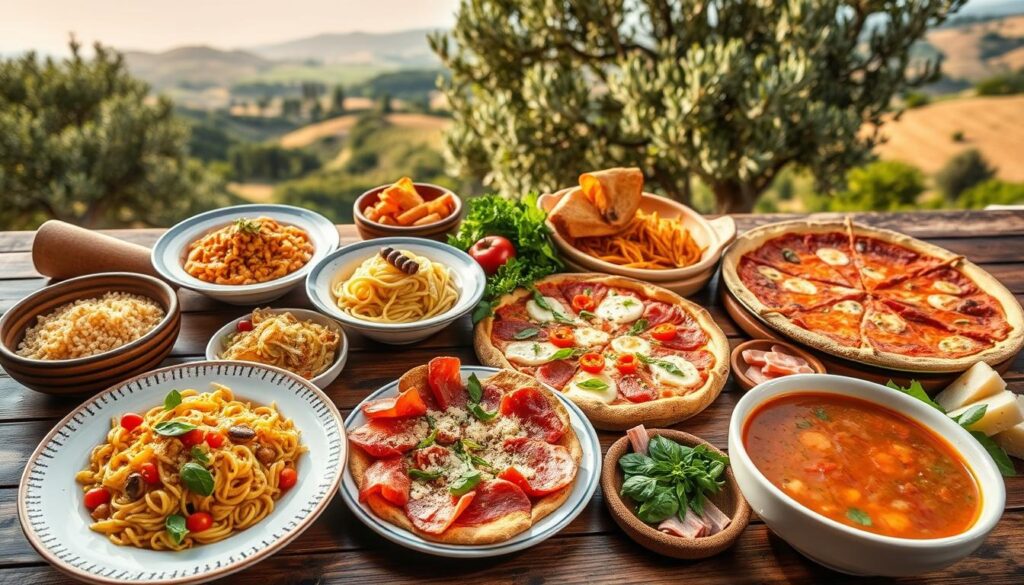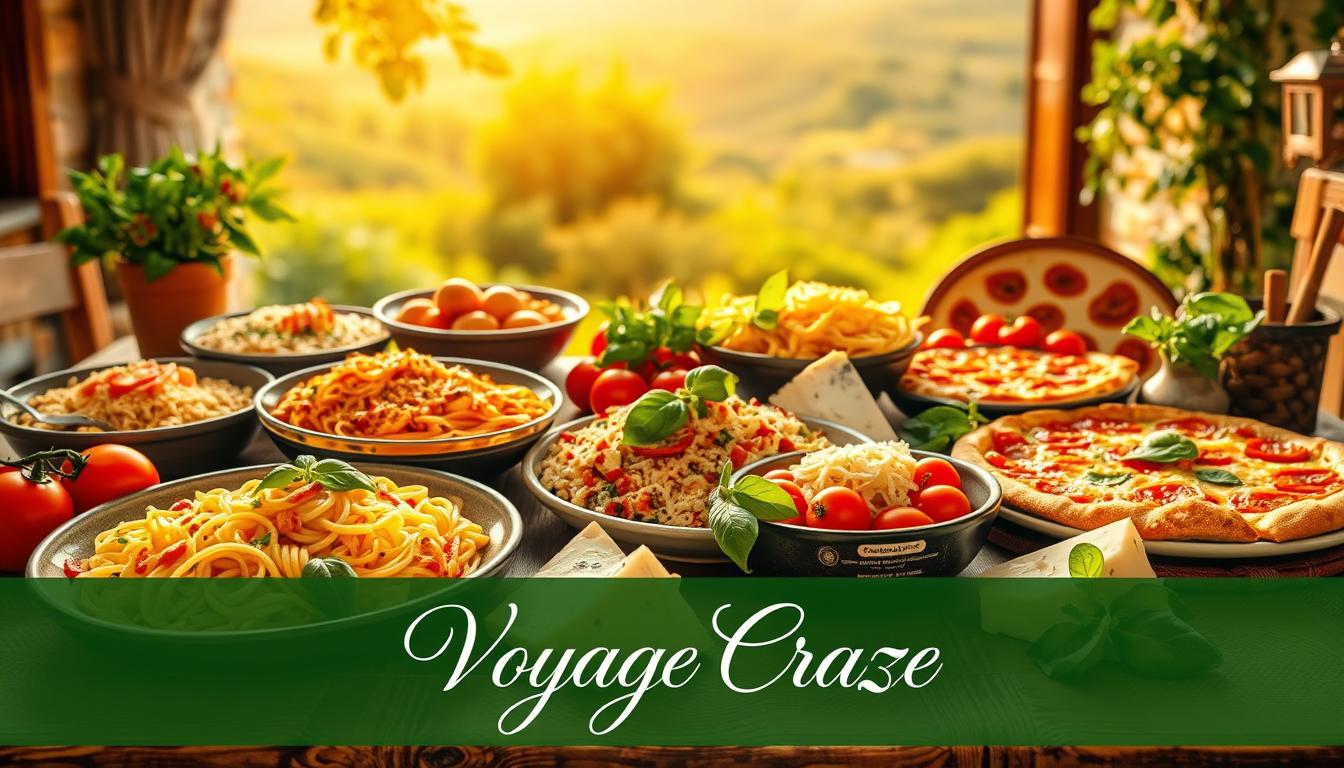Italian cuisine is a favorite around the world. It has a rich history and focuses on fresh ingredients. We’ll explore Italian food, including traditional dishes and recipes.
Italian food offers something for everyone. Whether you love pizza, pasta, risotto, or gelato, there’s something for you. This guide will help you discover the world of Italian cuisine.
We’ll dive into the history and cultural importance of Italian dishes. We’ll also talk about ingredients and cooking techniques. You’ll learn how to make delicious Italian dishes at home.
Key Takeaways
- Italian cuisine has a rich history and regional specialties
- Traditional Italian dishes are made with fresh ingredients and simple preparation methods
- Italian food recipes can be easily made at home with the right ingredients and cooking techniques
- Guide to Italian Cuisine includes a variety of dishes, from pizza to pasta and risotto to gelato
- Wine plays an important role in Italian cuisine, with many dishes paired with specific wines
- Italian cuisine is known for its emphasis on meal structure and cultural significance
- With over 6405 views of Italian cuisine content, it’s clear that people are interested in learning more about this beloved cuisine
A Brief History of Italian Cuisine
Italian cuisine has a long and varied history. It goes back to at least the 4th century BC. The cookbook *Apicius* from the 1st century BC has 470 recipes. This shows how Italian culinary traditions have been shaped by many cultures, like the Romans, Arabs, and Europeans.
Regional differences have greatly influenced Italian cuisine. The north favors fresh fish, potatoes, and heavier meats. The south loves dried pasta and lighter ingredients. This diversity is seen in Popular Italian dishes like pasta, pizza, and risotto.
Ancient Roots and Influences
New ingredients like potatoes and tomatoes changed Italian cuisine in the 18th century. These additions brought new flavors to traditional dishes. The Italian dining customs also changed, focusing on fresh ingredients and simple cooking.
Regional Diversity
Italy’s regions have their own special dishes. Liguria is famous for Pesto, Veneto for Risotto and Polenta, and Emilia-Romagna for Parmigiano Reggiano cheese. These differences make Italian cuisine rich and diverse, loved by people all over the world.
Evolution Through the Centuries
Italian cuisine has grown over the years. The Slow Food movement, started in 1986, fights for traditional cooking against fast food. This movement helps keep Italian culinary traditions alive, promoting the use of fresh ingredients.
Signature Italian Ingredients
Italian food is all about using fresh, top-quality ingredients. Olive oil is a key part of Italian cooking. It’s used for sautéing veggies and making sauces.
Some key ingredients that make Italian food special include:
- Olive oil, which is used extensively in Italian cooking techniques
- Fresh herbs and spices, such as basil, oregano, and rosemary
- Quality grains, including rice, pasta, and polenta
These ingredients are mixed using traditional Italian methods. Techniques like sautéing, braising, and roasting make dishes full of flavor. By using these ingredients and techniques, anyone can make delicious Italian meals at home.

Whether you’re a pro in the kitchen or just starting, knowing about Authentic Italian ingredients and techniques is key. It’s essential for making real Italian dishes.
| Ingredient | Description |
|---|---|
| Olive oil | A fundamental component of Italian cooking techniques |
| Fresh herbs and spices | Used to add flavor to a variety of Italian dishes |
| Quality grains | Include rice, pasta, and polenta, which are staples of Italian cuisine |
Classic Italian Pasta Dishes
Italian cuisine is famous for its wide variety of pasta dishes. You can find everything from spaghetti carbonara to lasagna and penne arrabbiata. These dishes highlight the best of Italian food recipes. Pasta has been a key part of Italian food for centuries, with each region adding its own twist.
Some of the most loved pasta dishes include:
- Spaghetti carbonara, made with bacon, eggs, and parmesan cheese
- Lasagna, layered with meat sauce, ricotta cheese, and mozzarella
- Penne arrabbiata, tossed with a spicy tomato sauce and topped with parmesan cheese
These dishes are not just tasty but also show the variety and depth of Italian cuisine. Each region brings its own special touch to Traditional Italian dishes and Italian food recipes. Whether you love food or just want to try something new, Italian pasta dishes will surely delight you.
The Art of Pizza
Pizza is a beloved Italian dish with a rich history. It has become famous worldwide. To make a true Italian pizza, knowing the difference between Neapolitan and Roman styles is key.
These styles have their own unique flavors and toppings. Neapolitan pizza is known for its thin crust and fresh ingredients like tomato sauce and mozzarella. Roman pizza, on the other hand, has a thicker crust and often includes olive oil and rosemary.

To make a tasty Italian pizza, quality ingredients and traditional methods are essential. Here are some tips for making pizza dough:
- Use tipo 00 flour for a smooth and elastic dough
- Keep the hydration level between 60-70% for Neapolitan pizza dough
- Allow the dough to ferment for at least 24 hours to develop the flavor and texture
By following these tips and trying out different recipes, you can make a delicious pizza at home. Whether you like Neapolitan or Roman style, the secret to a great pizza is using fresh ingredients and traditional cooking methods.
| Pizza Style | Crust Thickness | Toppings |
|---|---|---|
| Neapolitan | Thin | Tomato sauce, mozzarella, basil |
| Roman | Thicker | Olive oil, garlic, rosemary |
Traditional Sauces
Italian cuisine is famous for its wide range of traditional sauces. Authentic Italian ingredients are key in making these sauces. They use Italian cooking techniques that have been passed down for generations.
Popular sauces include Marinara, Pesto Genovese, and Alfredo sauce. These sauces are tasty and can be used in many dishes. They go well with pasta, pizza, meat, and vegetables.
- Marinara sauce: made with tomatoes, garlic, and herbs
- Pesto Genovese: made with basil, garlic, pine nuts, and Parmesan cheese
- Alfredo sauce: made with butter, cream, and Parmesan cheese
These traditional sauces are a big part of Italian cuisine. They are often mixed with other ingredients to make delicious dishes. By using Italian cooking techniques and Authentic Italian ingredients, you can make your own traditional Italian sauces at home.
| Sauce | Ingredients | Origin |
|---|---|---|
| Marinara | Tomatoes, garlic, herbs | Naples |
| Pesto Genovese | Basil, garlic, pine nuts, Parmesan cheese | Genoa |
| Alfredo | Butter, cream, Parmesan cheese | Rome |
Italian Regional Specialties
Italian cuisine is known for its regional diversity. Each region has its own specialties and ingredients. Regional Italian cuisine shows the country’s rich history, culture, and geography. From north to south, each region offers a unique culinary experience.
Tuscan Ribollita
Tuscan ribollita is a hearty soup with vegetables, bread, and cannellini beans. It’s a traditional Tuscan dish. It shows the importance of simplicity, freshness, and local ingredients in Italian culinary traditions.
Sicilian Caponata
Sicilian caponata is a sweet and sour eggplant relish. It’s often served as an antipasto or side dish. This Sicilian specialty reflects the island’s rich culinary heritage, blending Arab, Greek, and Italian influences.
Emilian Tortellini
Emilian tortellini is a traditional pasta dish from Emilia-Romagna. It’s filled with meat or cheese and served in a broth or with a creamy sauce. This dish is a staple of Regional Italian cuisine, known for its rich flavors and textures.

Exploring Italian culinary traditions is a journey of discovery. Each region offers a unique and authentic experience. Whether visiting Italy or cooking Italian dishes at home, try these regional specialties. Discover the rich flavors and traditions of Regional Italian cuisine.
Decadent Italian Desserts
Italian desserts are known for their richness and variety. They offer a wide range of options. From creamy panna cotta to crispy cannoli, there’s something for everyone. If you’re looking to try Italian food recipes at home, desserts are a great starting point.
Beloved Italian desserts include tiramisu, sfogliatelle, and gelato. These treats are not just tasty but also show the skill of Italian pastry chefs. Whether you prefer something classic or something new, Italian desserts will impress you.
Here are a few popular Italian desserts to try:
- Tiramisu: a creamy, coffee-infused dessert made with ladyfingers and mascarpone cheese
- Cannoli: crispy, fried pastry shells filled with sweet ricotta cheese
- Panna cotta: a creamy dessert made with sweetened cream that’s set with gelatin
With so many delicious options, it’s no surprise that Italian desserts are a favorite. Whether you’re a foodie or just looking to try something new, Italian desserts will satisfy your sweet tooth.
| Dessert | Description | Prep Time |
|---|---|---|
| Tiramisu | Creamy, coffee-infused dessert | 30 minutes |
| Cannoli | Crispy, fried pastry shells filled with sweet ricotta cheese | 2 hours |
| Panna cotta | Creamy dessert made with sweetened cream | 15 minutes |
The Role of Wine in Italian Cuisine
Wine is a big part of Italian food traditions. Italy has many wines to choose from. Each region in Italy has its own wine styles and pairings.
In Italy, wine is more than just a drink. It’s a key part of the meal. Italy makes about 47 million hectoliters of wine every year. This makes it one of the biggest wine makers in the world.
Wine pairs well with many Italian dishes. For example, Chicken Scaloppine goes great with Vernaccia. Shrimp Marinara pairs well with Pinot Grigio. And Chicken Marsala is best with Merlot. These pairings make the flavors of the dish even better.
Learning about wine in Italian cuisine can make your meals better. Italy’s wide range of wines and pairings offer a unique and exciting food journey. It’s sure to please your taste buds.
Cooking Techniques Essential to Italian Cuisine
Italian cuisine is famous for its simple and traditional cooking methods. To get good at Italian cooking, you need to know the basic techniques. These include sautéing, braising, baking, roasting, and grilling.
These methods help bring out the best flavors from ingredients. This way, cooks can make dishes that taste amazing and are true to Italian tradition. By using top-quality ingredients and mastering these techniques, home cooks can make dishes as good as those in restaurants.
Some key Italian cooking techniques include:
- Sautéing and braising, which involve quickly cooking ingredients in a pan and then finishing them in liquid
- Baking and roasting, which bring out the natural sweetness in ingredients
- Grilling, which adds a smoky flavor to dishes
By learning these Italian cooking techniques and using Authentic Italian ingredients, home cooks can make many delicious dishes. Whether you’re experienced or just starting, knowing and practicing these techniques will improve your Italian cooking.
| Cooking Technique | Description |
|---|---|
| Sautéing and Braising | Cooking ingredients quickly in a pan and then finishing them in liquid |
| Baking and Roasting | Cooking ingredients in the oven to bring out their natural sweetness |
| Grilling | Cooking ingredients over direct heat to add a smoky flavor |
Tips for Cooking Authentic Italian Meals at Home
Creating delicious Italian dishes at home is rewarding and achievable. You can do it by using the right ingredients, having the right tools, and simplifying recipes. This way, you can enjoy the flavors of Italy in your own kitchen.
Sourcing Ingredients
Look for local farmer’s markets, specialty Italian grocers, or online retailers for top-quality ingredients. Choose seasonal produce like spring asparagus, summer zucchini, and winter endives for the best flavors. Always check for “Imported from Italy” or “Product of Italy” labels on canned or packaged items to ensure authenticity.
Essential Kitchen Tools
Get the right equipment to make Italian cooking easy. Invest in a sturdy pasta maker, high-quality knives, and a reliable oven for baking pizzas and roasting meats. The right tools can make complex recipes simpler and lead to better results.
Simplifying Complex Recipes
Many traditional Italian dishes may seem hard, but they can be made at home with practice. Follow the “less is more” philosophy of Italian cuisine. Use a few fresh, quality ingredients that work well together. Adjust recipes to your taste and try new things with seasonal ingredients.







